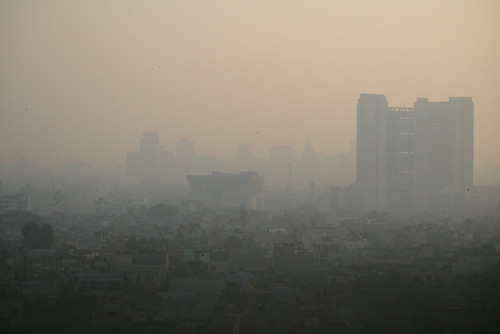
View of West of Delhi and air pollution
UNITED NATIONS: The “record-high” air pollution in New Delhi is a “wake-up call” for the world that unless decisive actions are taken to reduce air pollution, the smog in India’s capital and its adverse impact on the daily lives of its citizens will become a commonplace phenomenon, the United Nations children’s agency has said.
“With every breath, children in Delhi are suffering. Delhi is a wake up call to the world on air pollution. It is a wake up call to all countries and cities where air pollution levels have resulted in death and illness amongst children.
“It is a wake up a call that very clearly tells us: unless decisive actions are taken to reduce air pollution, the events we are witnessing in Delhi over the past week are likely to be increasingly common,” UNICEF said in a statement.
Air pollution level hit record high in New Delhi in the past week following Diwali celebration.
The capital’s smog, said to be its worst in 17 years, lead to the closure of the city›s over 5,000 schools to minimise the risk for children to be exposed to the polluted air and resulted in an estimated 4.41 million children missing three days of school, the United Nations Children’s Fund said.
According to estimates, air pollution levels hit 999 micrograms of particulate matter per cubic meter in some areas of the national capital, more than 15-16 times the limit considered safe.
The agency underscored that the alarming level of air pollution, which is major contributing factor to some of the most deadly diseases children face, is not just a challenge in Delhi but for many cities around the world.
Sounding an alarming note, the agency said almost a million children under-5 die from pneumonia per year – and about half of those cases are directly linked with air pollution.
“Air pollution levels in other Indian cities, such as Varanasi and Lucknow, have been equally extreme in recent days. And over the past year, air pollution levels in London, Beijing, Mexico City, Los Angeles and Manila have exceeded international guidelines – in some cases by considerable margin,” it said.
UNICEF had said in a recent analysis that globally 300 million children live in areas with the most toxic levels of outdoor air pollution – exceeding six times international guidelines.
It emphasised that nations need stronger measures to cut back on the sources of air pollution, which cannot be contained within borders and spreads across regions.
“Air pollution moves across borders, both national ones as well as subnational ones, and so we will need coherent government policies to address these transboundary risks,” it said.
UNICEF said providing children with access to good quality healthcare is a major part of protecting them from air pollution and treatment and prevention programmes for pneumonia, as well as other respiratory conditions, can significantly reduce the chance a child falls sick or dies.
“At a global scale, we need better monitoring of air pollution. When a child, a mother, a father or caregiver know how bad the air is on a real-time basis, they can begin to take actions to reduce exposure,” it said, adding that pregnant mothers, and others who are at especially high risk, should do their best to avoid areas where air pollution is at its highest. Source: http://www.navhindtimes.in/
